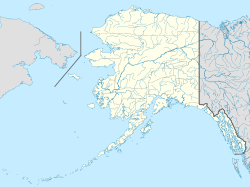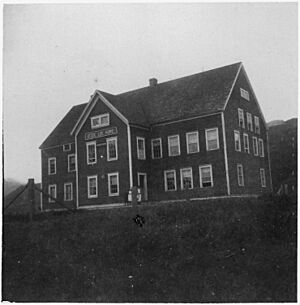Jesse Lee Home for Children facts for kids
Quick facts for kids |
|
|
Jesse Lee Home for Children
|
|
| Location | Benson Drive, Seward, Alaska |
|---|---|
| Area | 2.65 acres (1.07 ha) |
| Built | 1926 |
| Built by | John Holm; A.S. Hanson |
| Architect | Stanley Shaw |
| NRHP reference No. | 95001146 |
| Added to NRHP | September 29, 1995 |
The Jesse Lee Home for Children was once a special home for kids in Seward, Alaska. It was run by the United Methodist Church for many years, starting in 1926. Sadly, a big earthquake in 1964 damaged the building, and the home had to move to Anchorage.
Contents
A Home for Children
Before 1926, the Methodist Church had other homes for children in places like Nome and Unalaska. The home in Unalaska, which opened in 1889, was also a boarding school. It was called the Jesse Lee Home, named after an important Methodist minister.
Around 1918, a worldwide sickness called the Spanish flu spread. It was especially hard on remote Native villages, leaving many children without families. The old homes were too full and falling apart. Also, getting supplies and children to these far-off places was difficult and costly.
Seward was chosen as the new location because it was Alaska's biggest port and a major transportation hub at the time. This meant it would be cheaper to bring supplies and children from Seattle.
Life at the Home
Most of the children who lived at the Jesse Lee Home were Native kids from the Aleutian Islands (Aleut) and the Seward Peninsula (Iñupiat).
In 1926, the very first year the school opened, a 13-year-old student named Benny Benson won a contest. He designed the flag for the Alaska territory! His design is still used today as the official state flag. Benny had moved to the Jesse Lee Home from the old home in Unalaska.
- Benny's design was chosen from over 700 entries.
- A young Eskimo woman named Fanny Kearns, who worked as a seamstress at the home, sewed the first Alaskan flag.
- On July 9, 1927, a building called the Balto Building was dedicated. The new flag was raised for the first time at the Jesse Lee Home.
- This date is still celebrated as Alaska Flag Day.
Another student from the home, Ephriam Kalmakoff, won Seward's tough Mount Marathon Race in 1928 when he was just 14. He held the record as the youngest champion until 1957.
Peter Gordon Gould, another Aleut student, also lived at the Jesse Lee Home around the same time as Benny Benson. Peter later became the first president of Alaska Methodist University in Anchorage, which is now Alaska Pacific University.
Buildings and Changes
The Jesse Lee Home had three main buildings connected by covered walkways, plus several smaller buildings. The first buildings were two dormitories (places where students sleep) called Jewel Guard Hall and Goode Hall.
- The Balto Building was added between the two dormitories. It had dining areas and large kitchens.
- Jewel Guard Hall was the boys' dormitory. It also had a shop, classrooms for learning skills, a darkroom, a library, and a gym.
- Goode Hall was the girls' dormitory and held the main offices.
Other buildings on the property included a superintendent's house, a barn, a schoolhouse, a garage, and a cold storage building.
During World War II, the children living at the home were moved to other places for safety. The main buildings were painted in camouflage colors, and a temporary Army base was set up on part of the home's land.
After the war, the home reopened. However, students no longer attended classes at the home itself. Instead, they went to nearby Bayview Elementary and Seward High School. Also, the large gardens and livestock that used to feed the children were replaced by government-provided food. The number of children living at the home also dropped from a high of 120 to about 30 or 40.
The 1964 Earthquake
In 1964, a huge earthquake hit Alaska, causing severe damage in Seward and to the Jesse Lee Home complex. Goode Hall, one of the largest buildings, was so badly damaged it had to be torn down.
Because of the damage, the Methodist Church opened a new orphanage in Anchorage, and the Jesse Lee Home in Seward closed its doors. In 1966, the property was sold to the city of Seward. It was later sold to private owners but eventually returned to the city due to unpaid bills. The Jesse Lee Home was added to the National Register of Historic Places in 1995, recognizing its historical importance.
Efforts to Restore the Home
A group called "Friends of the Jesse Lee Home" was created. Their goal was to restore the historic site. They hoped that once fixed up, the Jesse Lee Home could become a public high school focused on leadership for students across Alaska.
- In 2002, the Alaska State Legislature passed a bill to help acquire and develop the Jesse Lee Home.
- A study in 2003 found that the building was still structurally sound, meaning it was safe and strong.
- In 2008, the Alaska Department of Commerce gave a $1,000,000 grant to help repair and stabilize the home. The Friends of the Jesse Lee Home group was put in charge of the project.
- Since then, the State of Alaska has provided a total of $8,000,000 to help plan how the "Balto School" (a new school idea) would use the building and to renovate the parts of the Jesse Lee Home that are still standing.
Demolition
Despite all the efforts and money raised to restore the site, the demolition of the Jesse Lee Home began on November 4, 2020.



